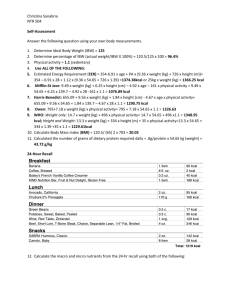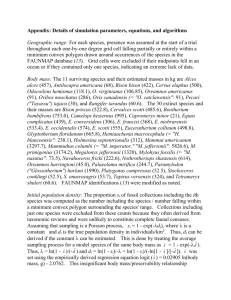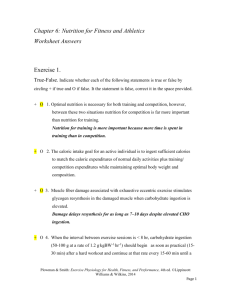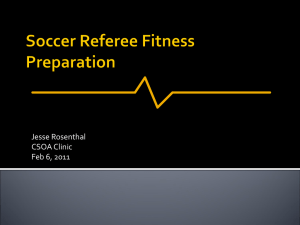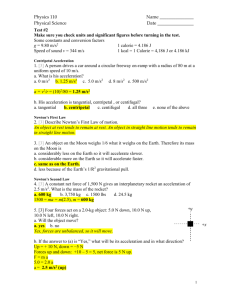NASM OPT Model
advertisement
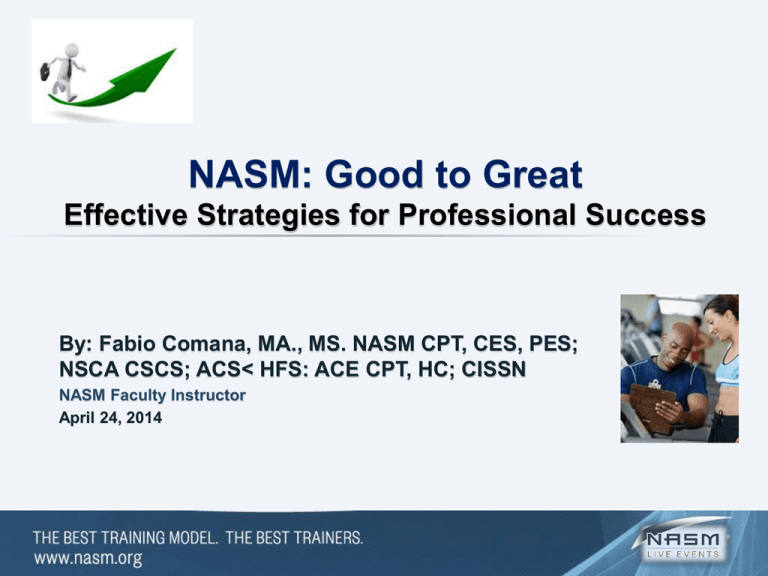
NASM: Good to Great Effective Strategies for Professional Success By: Fabio Comana, MA., MS. NASM CPT, CES, PES; NSCA CSCS; ACS< HFS: ACE CPT, HC; CISSN NASM Faculty Instructor April 24, 2014 Customer Retention/Referrals • How many customers have you lost in the past 6 months? • How do you define and measure your losses? – Financial? – Lack of Satisfaction? – Not Giving you Recommendations? Do you understand why? • How many customer referrals have you received? • Are they your ambassadors? Session Goals and Outcomes • Think Differently … • Examine Existing Methodologies … • Evaluate New Opportunities … Awareness Intention Planning Execution Micro-segmentation: Identify Your Audience Who do you Serve? Satisfied • 22.2 million Americans adults utilize club memberships ≥ 100x/year. o o • 4 million American adults utilize PT. 9 – 17 million American adults participate in GF Represents individuals currently subscribing to, & renewing your services. Dissatisfied • • • Represent part of 28.2 million Americans adults with memberships, but visit < 100x/year; and many adults (% of 243.7 million) not in clubs. Generally unhappy, frustrated or disappointed with paid services. Also represent individuals who purchased, now no longer utilize services - see little-no value, yet seek solutions. Unsatisfied • Met expectations, but seeking something more or different. Micro-segmentation: Identify Your Audience Health Club Members 243,735,00 0 Adults in U.S. 50,400,000 Members of Health Clubs (20.7%) 9 – 17.6 million Group Participants (5.4 % of Population) 4 million PT Clients (1.7 % of Population) Health Club Utilization 12 % Naysayers 45 - 55 % Self-directed 28.2 million Irregular Users 22.2 million Regular Users 8% Personal Training 33% Ambivalent Micro-segmentation: Identify Your Audience You provide a product that MUST hold value or you are irrelevant. • Value of your product (service) is only as good as the importance and relevance it holds in the customer’s eyes. Population Distribution Value of your Product Innovators (2.5%) Early and Late Majority (Mass) (67- 70%) Laggards (12 – 17%) Early Adopters (13.5%) Innovators • • • Generally unsatisfied; seeking innovative ideas (Vibram/Nike - 2005) – revolutionary Influential (endorsements) Tech savvy – how will you reach them? Early Adopters • • See benefits (how it will help their lives) – evolutionary Very influential (need a medium to communicate with EM/LM Early / Late Majority Want evidence of success (referrals), build relationships. Success requires 18% penetration of your target audience Questions to Consider: 20.7 % of adult population belong to health clubs – is fitness irrelevant? Why do only 9.2 % (22.2 million members) use facilities 100x / year? Why do 22% of members cancel their memberships each year? o 68% are generally dissatisfied. We may (think we) understand what people need, but do we fully understand what they desire? o Achievement (results)? – Recognition, motivation, experiences? o IHRSA and SGMA (2012) – Decreasing solo activities / increasing social activities. What barriers limit participation? o EMT: Energy (fatigue), motivation (lack of), time. Issues with the Fitness Industry in General: • Primary: History of taking a directive (tell) approach v. semidirective (ask- empower) approach. o Isn’t a diet also a directive approach (we tolerate what we accept) o What are the consequences of such actions? • Other Considerations: o Perceptions… Exercise vs. movement? Exercise as a solution to weight loss? a. Weight loss = #1 reason for joining clubs. b. Weight loss = #1 health concern. o Exercise experiences? (especially with today’s types of programs (high-work-rate programming) – Biggest Loser? Is Exercise Enough for Weight Loss? 17,514 kcal/week Exercise and Caloric Burn in General: • Average US Male: 195.5 lb. (88.9 Kg) • Average US Female: 166.2 lb. (75.5 Kg) 12,446 kcal/week NHANES, 2007- 2010 Average Intake (Male) 2,000 kcal 1,490 kcal 1,150 kcal 1,174 kcal 640 kcal Need for Weight Cardio Rx Res Rx (4x60min; 1- MetCon Res Rx Loss (weekly) (4x30min@ 5.5mph) to-2 WR Ratio) (3x40min; 4-to-1 WR ratio) Walking (3x45min@3mph) Average Intake (Female) Measure Men Women (195.5 lbs. / 88.9 Kg) (166.2 lbs. / 75.5 Kg) Cardio Program: 1,616 kcal 1,373 kcal 4 x 30 min @ 5 mph (10.4 % of caloric intake total) (11.0 % of caloric intake total) Min needed to target 2,000 kcal: Additional 28 minutes a week Additional 55 minutes a week Weight Training: 4 x 60 min (1-to-2 work-torecovery ratio) 1,245 kcal (8.0 % of caloric intake total) 1,057 kcal (8.5 % of caloric intake total) Min needed to target 2,000 kcal: Additional 145 minutes a week 1,270 kcal (8.2 % of total caloric intake) Additional 214 minutes a week 1,078 kcal (8.7 % of total caloric intake) Walking: 692 kcal 3 x 45 min @ 3 mph (4.5 % of total caloric intake) Min needed to target 2,000 kcal: Additional 255 minutes a week Additional 103 minutes a week 588 kcal (4.7 % of total caloric intake) Additional 324 minutes a week Metabolic Resistance Circuit: Integrated or whole body 3 x 40 min higher-intensity (4-to-1 work-to-recovery ratio) Min needed to target 2,000 kcal: Additional 69 minutes a week Adherence? Are You Concerned? Self-Efficacy? Overall Experience? Physiological Harm Appropriate Experience Cognitive & Emotional Impact? Physical Ability? Psychological and Emotional Impact Results? Quit? Injury? Purpose? Harm Experience Repetitive trauma DOMS Fatigue and Technique Competency Impression Immune Response Decisions – 56.2% (quitting) Sport & Exercise-related Injuries Injuries in Recreational & Sports Facilities Sprain/Strain-type Injuries 1997 13.4 % of all injuries 11.6 % of all injuries 26.4 % of all injuries 2007 17.9 % of all injuries 15.0 % of all injuries 30.7 % of all injuries Building Value Price is only a factor in the absence of value What is your/your department’s Mission Statement or statement of purpose? • Why is this so important ? – your moment of truth (i.e., 30-sec elevator pitch). • Hint – think how your tribe can spread your message via word of mouth? Task – Paper & Pencil 92% of consumers trust friends & family above all other forms of advertising (18 % increase since 2007). 70% of consumers trust stranger testimonials (15 % increase since 2007). Nielson Report, 2011 Give it you your neighbor – read it asking so what?? What does it mean to me – how does it make me feel? How does that benefit me? Do I like it, do I desire it, and do I want to buy it now? • Does it contain dialogue that communicates 3 things: o What service you provide? o Why? What does your service mean to customers (i.e., what makes you or your service / product unique and compelling)? o Some mention of who you are – to your target audience? • Does it connect at an Emotional Level (e.g., pain = a key success of Trigger Point®). Is it a Purple Cow ? Building Value Why • In describing what you do, do you start (emphasize) from the outside-in, or inside-out? (The Golden Circle) How What “We make computers using the latest technology to make your life convenient” – amended from Dell “In every idea we touch and every product we develop that enhances your life experiences, we think differently. Why – because that is what matters to you, so we work relentlessly using technology to achieve that goal. You may not look at it, but you’ll always feel it – it is our signature and it means everything” – amended from Apple • This is a fundamental difference between branding and marketing !! o Marketing: Creates action/response (i.e., purchase, fulfills needs that achieve satisfaction) – Cortex (rationale – “what”). o Branding: Creates reaction - connecting emotionally (i.e., fulfills desires that build commitment) – limbic system (emotional – “why”). Maslow’s Hierarchy of Needs Intangible SelfActualization Transformational Self-Actualization Esteem Success Social / Belonging, Esteem Social/Belonging Survival Physiological / Safety Safety Tangible Physiological Reference: Chip Conley: Peak Lower needs MUST be fulfilled before moving upwards Building Value Unexpected Payoff – Dopamine increase (e.g., Facebook Like/Share) Meet Unrecognized Needs – Creates Evangelism … Ask Yourself Meet Desires – Creates Commitment … Meet Needs – Creates Satisfaction … Antenna up, radar on – Ritz Carlton People don’t know what they want until you show them – Steve Jobs Hierarchies in Fitness Employee Transformational Customer Meaning* (calling) Transformational Success Recognition – Advancement (career) Success Survival Compensation (job) Survival Transformation Care (VIP), Support Goals, Safety Too self-focused on bottom of the pyramid Although money (survival) is important – it is not a primary motivator? • • Dissatisfaction with compensation is a gross de-motivator. Satisfaction with compensation is not a gross motivator. Deepest hunger in humans is the desire to be appreciated – William James, philosopher/psychologist * Meaning at Work – How do you feel about company and company mission statement? Meaning in Work – How do you feel about your tasks? Both need to be high…. Compensation is a right – recognition is a gift – Rosabeth Moss Kanter Transformational Stage Three Federal Express When it Absolutely, Positively has to be There Overnight Success Survival Stage Two Enterprise We’ll Pick You Up Stage One Provides solution for those in need of transportation (when own cars in for repair). Are they selling shipping or piece of mind? Business Development Stages • • • • • • • Stage One – Develop an acceptable product to meet expectations – become irrelevant. Stage Two – Develop products in response to addressed needs/desires – extend lifespan of existing customers. Stage Three – Innovative and identifying unrecognized needs.. Sony pioneered portable music (Walkman) – why did they not develop the iPod? ATT owned the phone business – why did they not develop the cell phone? Avis and Hertz owned rental space – why is Enterprise the big player? USPS delivered all mail – why is Fed-Ex so successful? Hierarchies in Business Apple™ Transformational Success Survival Whole Foods™ Sense you can Achieve Anything Transformational Hip, Cool, Innovative Clubhouse / Genius Bar Quality Products What is Your Product? Transformational Success Survival Success Survival Sense of Sustainability (planet) Sense of Community Fresh and Abundant Food How do You know? Self-Actualization – Empowered (e.g., I become a trainer) Esteem – Recognition / Show then you Care (external / internal) Belonging – Member-to-member Connection, Camaraderie (GPT, Group) Safety – No Injury Physiological – Weight Loss Branding People define themselves through brands (social acceptance/rejection) • Be remarkable / be outrageous sometimes: (UVV – Unique, Valuable & Visible) o Create your unique selling proposition (USP) that holds value, importance and relevance in your customer’s eyes. o Brands validate identity & self-worth. Tribe T-shirts, Graduation Self-appraisal (looks, knowledge, etc.), Self-perception (sense of worth by self and others). 92 % of people who own BMWs rent… do not own. Building Value • Are you listening to your clients (customers) or potential customers? Exit Surveys – S.W.O.T • • • Don’t fall into traps – doing things the same way because you think it works... Know what is important to your audience (responsive listener) - inquire / anticipate future needs – remain relevant!! Keep existing tribe members (customers) = 6x < expensive than new ones. Complacency Lack of Curiosity Consistency is good - avoid repetition. Pushing boundaries; explore new opportunities. Self-focus Push our message - forget what is important to members / clients. Strengths Weaknesses Opportunities Threats Be inquisitive What people think of as the moment of discovery is really the discovery of the right question – Jonas Salk Conduct Your Own SWOT Analysis • List 3 key strengths and weaknesses • List 3 opportunities and weaknesses o Ask what they wish you could provide – is that a weakness or opportunity? • Perform a gap analysis … Complete this from the perspective of the customer, not yours…. Task – Paper & Pencil Why do you care? You need to build, grow and maintain your business… You need their referrals. You need to listen and be responsive listeners.. Building Value The one question we all want to know? ….. • Measures intangible customer loyalty and word-of-mouth opportunities Score 60 – 80% of defectors rate “satisfied’ / “very satisfied” 1-6 7-8 9 - 10 Detractors (D) Passive Promoters (PP) Active Promoters (AP) Dangerous members – No real loyalty/commitment – perhaps dissatisfied/unsatisfied only to your products / programs Baseline Expectation Reality Meeting Needs Ambassadors / Sneezers (raving fans) Meeting Desires Meeting Unrecognized Needs Net Promoter Score = AP – D No more than 5 % Motivational Interviewing Consistency in your product • Starbucks, McDonalds Personality Indexing Consistent message for your Tribe Members to sneeze Rapport and Communication Cardio Power Functional / Performance Strength (Power) Cardio Endurance Fundamental Strength (Load) Cardio Base Foundational Strength (Stabilization - Volume) Fitness Industry Landscape How is our Industry Changing – Shape-shifting: • Perception of gym MUST change: o Less intimidation. o More open space. o More diverse (and specialized) services. Know your niche market - concierge services for upscale clubs • All-inclusive activities / changing business models: o Expansion beyond brick-and-mortar – community programs through club (inside/ outside – e.g., Zumba community). o Business of the gym MUST change o Drop-in programs / training v. traditional committed. o Finite vs. perpetual (pay as you go) Fitness Industry Landscape How is our Industry Changing – Shape-shifting: • Exergaming / Edutainment: o Do you possess the skills and infrastructure? o Does this open up additional revenue streams and audiences? • Embracing / Collaborating / Co-branding with Technology: o Quantified Self (Mobile Health and Fitness Apps – almost $60 billion by 2017). o TEDex™ events – use wellness to bridge gap between technology (which we all use) and fitness. o Community events – local channels. Fitness Industry Landscape Health Trifecta: Aging demographics (55+), obesity & inactivity = health care costs increasing 7 – 8 % annually. • American health care system: $ 2.3 trillion (2006) v. $ 4.1 trillion (2016). • $1 out of every $6 spent on obesity-related issues (2030). Wellness $300 Billion (10 years) Fitness $26 Billion (37 years) Healthcare Costs & Reforms: Self-care / Home-care (preventative) Employers Paying employees for + health outcomes Insurers Penalizing unhealthy employees Incentives / reimbursements to companies & individuals - $4 million to Anytime Fitness (2011) Coaches The New Personal Trainer Personal Training / Teaching Coaching 2 – 5 hours / week 110 – 115 hours / week Directive approach (tell-orientated) More one-dimensional approach (emphasize physical/physiological changes) Semi-directive approach (ask –orientated, more collaborative) Multi-dimensional (psychological, emotional, physical) (not therapeutic or counseling - change, not cure) Coaching People seek a change (outcomes & process), but why won’t / can’t they change? Fogg Behavioral Model (FBM) • Successful behavioral change is a product of 3 factors – motivation, ability & triggers occurring at same instant. Trigger(s) High DESIRABLE BEHAVIOR What are we trying to do? Initiate new/familiar behavior(s) MOTIVATION Behavior Activation Threshold (BAT) Low Low High ABILITY Increase existing (desirable) behavior(s) Cease existing behavior(s) Decrease existing (undesirable) behavior(s) Building Importance and Relevance • • • Identify 6 – 10 Core Values (what you hold dear and sacred) using an inventory sheet. Score Level of Importance (LI) using 1 – 10 scale. Score Level of Satisfaction (LS) using 1 – 10 scale. Value □ □ □ □ □ □ □ □ □ □ □ □ Physiological Function / Capacity Physical Environment Self-management Money and Financial Wellness Health and Well-being Nutrition Physical Fitness Stress Family Friends Personal Growth & Development Emotional Health Value □ □ □ □ □ □ □ □ □ □ □ □ Self-esteem Self-efficacy Significant Other Romance & Intimacy Fun and Recreation Spirituality Intellectual Function Cognitive Function Social Interaction Cultural impact Occupational Satisfaction / Career Others: _____________________ Interpretation • Examine quantitative difference and your Net Aggregate Score (NAS) o NAS = Total LS – Total LI Example: NAS = 25 – 38 = - 13 • Connect core values to a change process to build importance and relevance Wellness 10 10 9 9 7 5 4 Health Sleep Family LI LS Career 9 Strengthening Commitment to Change Poor Experience – Reset Challenges / Rescore A Systematic Approach: Set a Process Goal Challenge Evaluate the Experience Try it Once Score Score • • • • Level of Confidence (1 – 5) Level of Ability (1 – 5) Extend the Finite Period Experience (1 – 5) Likelihood to Sustain (1 – 5) Evaluate the Experience Try for a Finite Period Score Score • • • • Experience (1 – 5) Likelihood to Sustain (1 – 5) Level of Confidence (1 – 5) Level of Ability (1 – 5) References and Reading List 1. 2. Websites: www.IHRSA.org; www.clubsolutionsmagazine.com; www.clubindustry.com Collins, J, (2001). Good to Great: Why Some Companies Make the Leap... and Others Don't. Harper Collins, New York, NY. 3. Pendleton, K, (1984). The Consultation: An approach to learning and teaching. Oxford University Press: Oxford, UK. 4. Conley, C and Hsieh, T (2007). Peak – How great companies get their mojo from Maslow. San Francisco, CA, Jossey-Bass. 5. Godin, S, (2009). Purple Cow. New York, NY. Portfolio - Penguin Group 6. Godin, S, (2008). Tribes - We need you to lead us. London, UK. Penguin Book 7. Heath, C and Heath, D (2010). Switch – How to Change Things When Change is Hard. New York, NY: Broadway Books. 8. Moran, B, (2013). The 12-week Year: Get done in 12 weeks what others do in 12 months. Hoboken, NY. John Wiley & Sons. 9. Reichheld , F (2011). The Ultimate Question 2.0. Boston, MA. Bain & Company. 10. Zaltman, G, (2003). How Customers Think: Essential insights into the mind of the market. Boston, MA. Harvard Business School Publishing. 11. Moore, J, (2002). Crossing the Chasm. New York, NY. HarperCollins Publishing. Questions? Contact Information • Fabio Comana – Fabio.comana@nasm.org Thank You! For Your Commitment to Excellence Additional Professional Opportunities • We are offering 20% off CPT promo code: FITCPT and 15% off specializations with promo code: FITFEST • Visit us online at www.nasm.org/credentials for more product information

